Daily News
by Gail Helmer
[ Send Us News | Archives ]
Producer's Journal, Lock On: Modern Air Combat
Ubi Soft Producer Matt "Wags" Wagner has posted a new developer journal which focuses on three common Lock On themes from the community forums. Matt addresses several misconceptions about Lock On, answers a few questions, and writes about some specific goals and expectations during the next months of development. Read journal
New Screens: Ghost Recon Mission Pack
Ubi Soft has released new screens from their upcoming title, Ghost Recon: Mission Pack. The pack will ship in March 2002 and will contain 8 new Single-Player missions. The missions will be based in North Africa, focusing on a future conflict between Ethiopia and Eritrea. The Mission Pack will feature a new environment - the Eritrean desert, new enemies and new desert uniforms for the Ghosts. 4 New Multiplayer spaces will also be included in the Mission Pack.
Take Two Trading Halted
Nasdaq Monday halted the trading of Take Two Interactive Software shares until further information was provided by the company regarding its financial reporting. Trading in the company was halted Monday at 4:09 p.m. EST after the company postponed the release of its Q4 financial report. Last month, Take Two announced it would have to restate its earnings for all of fiscal 2000 and the first three quarters of 2001 due to faulty revenue accounting that artificially inflated its top line. The Nasdaq trading halt will remain in effect until the company has "fully satisfied Nasdaq’s request for additional information," according to a Nasdaq press release.
Bohemia Interactive's Upcoming Project Revealed
Bohemia Interactive, the studio that created the popular Cold War-era tactical combat game Operation Flashpoint, has launched a Web site for Independence Lost, its upcoming project. The site contains some background information about the East Timor area, along with some screenshots showing off various modern-day helicopters and military ships. While the site notes that Independence Lost is scheduled for release in 2002, no further information about the project is available, and it is unknown whether it is a stand-alone game or an expansion for Operation Flashpoint.
Military News
BAE SYSTEMS Hands Over First Mk106-Engined Jaguar To DLO
The first of 62 RAF Jaguar GR3a aircraft powered by upgraded Adour engines was officially handed over to the UK's Defence Logistics Organisation on 28 January. The aircraft flew from BAE SYSTEMS Warton to RAF Coltishall in Norfolk on 24 January.
The Ł105 million contract for the upgrade was let to BAE SYSTEMS by the Defence Logistics Organisation's Equipment Support (Air). BAE SYSTEMS Customer Solutions and Support business is prime contractor and has worked with ES (Air) and Rolls Royce to develop and integrate the engines with the aircraft.

Following an extensive development and test programme BAE SYSTEMS and Rolls Royce declared themselves very pleased with the engine performance and its handling. BAE SYSTEMS test pilot and Director of Flight Operations Derek Reeh said, "This has been an extensive integration programme that has tested the aircraft to the extremes of the flight envelope. The new engine is more surge-resistant than previous Adour variants and performs well even at the limits. Aircraft handling is unaffected and the performance enhancements will improve take-off performance at high ambient temperatures."
Over the years the basic all-up weight and drag of the aircraft have increased, causing the current engines to have to work much harder. An investment appraisal showed that an engine modification using the latest Adour technology, already proven in the export market, was the most cost effective option to reduce operating costs and overcome the operating shortfalls in a timescale that would realise Life Cycle Cost (LCC) benefits. The modified engine is intrinsically more powerful than the Mk104 but will be configured to optimise engine life cycle costs and thus produce maximum savings. In addition to the increased reliability and lower operating costs, even in its optimised condition the Mk106 engine will provide a modest increase in thrust over the Mk104.
The first two aircraft have been converted at BAE SYSTEMS Warton. The remainder will be converted at DARA St Athan with the last aircraft scheduled for completion by the end of 2005.
Produced to meet a joint Anglo-French requirement in 1965 for a dual-role advanced/operational trainer and tactical support aircraft, the Jaguar has been transformed into a potent fighter-bomber and is increasingly used for reconnaissance missions. The Jaguar is currently in service with the RAF, the French Airforce, India, Ecuador and Oman.
A variety of weapons including cluster, freefall, retard and laser guided bombs, as well as rockets can be carried on the four wing and one fuselage stations. Two 30mm cannons are mounted internally. To mark targets for laser-guided weapons, the aircraft carries the thermal imaging and laser designation (TIALD) pod. For self-defence, overwing Sidewinder infra-red missiles are carried and the aircraft is fitted with a comprehensive suite of electronic countermeasures.
Teamwork Moves F-16 CCIP Ahead of Schedule
Close cooperation between Lockheed Martin Aeronautics Company and the U.S. Air Force enabled the Ogden Air Logistics Center (ALC) to complete modification of the first U.S. Air Force aircraft in the F-16 Common Configuration Implementation Program (CCIP) ahead of schedule.
Ogden ALC is the primary depot for the worldwide F-16 fleet. The aircraft, a Block 50 F-16C, was ferried to Shaw Air Force Base, S.C., on Jan. 11, and arrived there in Code One condition (no flight discrepancies). The 20th Fighter Wing at Shaw is the first unit to receive the F-16 CCIP aircraft.
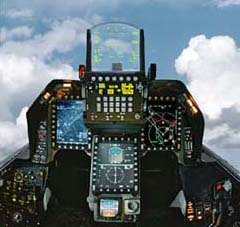
"Delivery of the first CCIP aircraft from the modification line is an important milestone in the program," said William J. Lake, director of USAF F-16 Programs. "It won't be long before these aircraft begin operational service, and we expect great acceptance by the pilots and maintainers alike."
The F-16 CCIP, valued at over $1 billion, will significantly enhance the cockpit and avionics of about 650 Block 40/50 F-16s in the USAF inventory. The modification will provide hardware and software commonality to the USAF Block 40/50 fleet, thus improving logistics support and reducing costs of future upgrades. In addition, the modification provides a high degree of commonality with F-16A/Bs being upgraded by five European NATO countries and with advanced Block 50/52 versions currently being developed for several other countries.
CCIP modification of aircraft is being implemented in phases. The first phase involves only new core computers and color cockpit modifications to some Block 50/52 aircraft. In September 2002, Block 50/52 aircraft will begin receiving the advanced interrogator/transponder and will be able to employ the Lockheed Martin Sniper XR advanced FLIR targeting pod.
The next phase, starting in July 2003, adds the NATO-standard Link 16 data link, the Joint Helmet-Mounted Cueing System and an electronic horizontal situation indictor. The Block 50/52 aircraft receiving the modifications in the earlier phases will go back through the depot mod line at Ogden to receive the additional changes. The Block 40/42 versions will receive the entire modification all at one time, beginning in 2005.
Trident II D5 Missile Production Goes To Lockheed Martin
The US Navy has awarded Lockheed Martin Space Systems-Missiles & Space Operations a $248 million contract for the follow-on production of 12 Trident II D5 Fleet Ballistic Missiles (FBM) and start of the D5 service life extension (LE) program. The contract also includes procurement of additional critical components needed to extend the operational service life of the highly successful Trident II D5 missile system.
The contract for production of D5 missiles is part of the retrofit of four Trident Ohio-class submarines. The 12 missiles will support operational deployments of the USS Henry M. Jackson (SSBN-730), USS Alabama (SSBN-731), USS Alaska (SSBN-732), and USS Nevada (SSBN-733), which are being converted to carry Trident II D5 missiles, from Trident I C4 missiles. Production of the missiles will begin in 2002, with an expected delivery to the Navy in 2004.
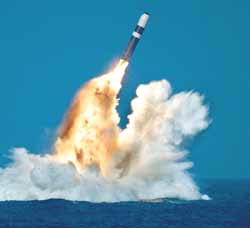
Under the D5 service life extension portion of the award are additional rocket motors and other components, which are required to support the higher D5 missile inventory required due to the US Navy's 1998 decision to extend the TRIDENT Ohio-class submarine's service life from 30 to 44 years. Also included is re-qualification of production sources for materials previously bought out to the 30-year service life missile inventory objective. The D5 service life extension is expected to make the D5 missile operationally viable until 2040.
"We are extremely gratified that the government has decided at this critical time to moved forward with the strategically important D5 LE program," said Tom Morton, vice president, Lockheed Martin Strategic Missile Programmes.
Technology Flow Helps Rolls-Royce Win Type 45 Destroyer Contract
Rolls-Royce has won a contract worth approximately Ł20 million to provide propeller shaftlines and other equipment for the first six Royal Navy Type 45 destroyers. The company was selected, under competitive tender, by the BAE Systems Type 45 Prime Contract Office to provide a system of two propeller shaftlines per ship with steering gear and stabilisers. Deliveries for the first ship will be completed in 2004.
"The latest contract marks the first time Rolls-Royce has responsibility for the shaftline on a Royal Navy project, increasing our role in the ship's power train, " said Saul Lanyado, Rolls-Royce President - Marine. "This is also an example of technology flow. The propeller was developed within our commercial business, but will now be part of a naval power solution."
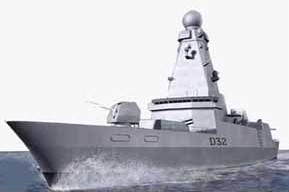
The company will provide adjustable bolted propellers for the Type 45s, featuring blades that can be replaced underwater without dry-docking. Slotted holes on the hub also allow the blade pitch angle to be adjusted by up to three degrees, retaining propeller efficiency over the vessel's life as hull resistance changes. Rolls-Royce and Northrop Grumman are already contracted to provide 12 WR-21 gas turbines for the first six Type 45s.
Canada To Play Role In JSF Program
Kathy Crawford, Pentagon spokeswoman for the JSF program, says that Canada will have a role in development of the Lockheed Martin F-35. Canada, in a deal to be formalized a week from now, will contribute about 1 percent to the research and development costs of the Joint Strike Fighter. Canada's "Level III" involvement will cost our northern neighbor about $200 million (US).
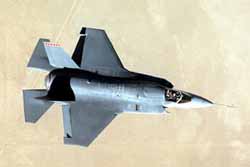
Canada will, in turn, have some technology spillover, and be able to get in line to buy the supersonic, stealthy, STOVL fighter. That $200 million is estimated to be about 1% of currently-known development expenses. Australia, meanwhile, long interested in the program, is in talks with the DoD to enter at "Level II," a 3~5% commitment. When the fighter does get sold five years from now, it should cost about the same as an F-16 -- $30 to $50 million -- and perform as well, but with the additional advantages of STOVL and stealth, and some presumed efficiency in cruise.
A Lethal Hit
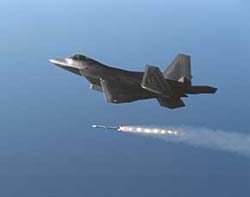
Behind the controls of Raptor 4005, Col. Chris Seat, director of the F-22 Raptor Combined Test Force here, fires a guided AIM-120 air-to-air missile and destroys a subscale drone over a test range at Point Mugu Naval Air Station, Calif. on Jan. 24. This missile test demonstrates the Raptor's look-down, shoot-down capability, which allows it to target, track and destroy a target that is pulling away. The combined test force here is currently testing six F-22s. Since the start of testing nearly four years ago, the F-22 test program has flown more than 1,628 hours and completed more than 729 flight-test sorties. (Photo by Steve Zapka)
[ Send Us News | Archives ]
by Gail Helmer
Wednesday January 30, 2002
- Producer's Journal, Lock On: Modern Air Combat
- New Screens: Ghost Recon Mission Pack
- Take Two Trading Halted
- Bohemia Interactive's Upcoming Project Revealed
- BAE SYSTEMS Hands Over First Mk106-Engined Jaguar To DLO
- Teamwork Moves F-16 CCIP Ahead of Schedule
- Trident II D5 Missile Production Goes To Lockheed Martin
- Technology Flow Helps Rolls-Royce Win Type 45 Destroyer Contract
- Canada To Play Role In JSF Program
- A Lethal Hit
Producer's Journal, Lock On: Modern Air Combat
Ubi Soft Producer Matt "Wags" Wagner has posted a new developer journal which focuses on three common Lock On themes from the community forums. Matt addresses several misconceptions about Lock On, answers a few questions, and writes about some specific goals and expectations during the next months of development. Read journal
New Screens: Ghost Recon Mission Pack
Ubi Soft has released new screens from their upcoming title, Ghost Recon: Mission Pack. The pack will ship in March 2002 and will contain 8 new Single-Player missions. The missions will be based in North Africa, focusing on a future conflict between Ethiopia and Eritrea. The Mission Pack will feature a new environment - the Eritrean desert, new enemies and new desert uniforms for the Ghosts. 4 New Multiplayer spaces will also be included in the Mission Pack.
Take Two Trading Halted
Nasdaq Monday halted the trading of Take Two Interactive Software shares until further information was provided by the company regarding its financial reporting. Trading in the company was halted Monday at 4:09 p.m. EST after the company postponed the release of its Q4 financial report. Last month, Take Two announced it would have to restate its earnings for all of fiscal 2000 and the first three quarters of 2001 due to faulty revenue accounting that artificially inflated its top line. The Nasdaq trading halt will remain in effect until the company has "fully satisfied Nasdaq’s request for additional information," according to a Nasdaq press release.
Bohemia Interactive's Upcoming Project Revealed
Bohemia Interactive, the studio that created the popular Cold War-era tactical combat game Operation Flashpoint, has launched a Web site for Independence Lost, its upcoming project. The site contains some background information about the East Timor area, along with some screenshots showing off various modern-day helicopters and military ships. While the site notes that Independence Lost is scheduled for release in 2002, no further information about the project is available, and it is unknown whether it is a stand-alone game or an expansion for Operation Flashpoint.
Military News
BAE SYSTEMS Hands Over First Mk106-Engined Jaguar To DLO
The first of 62 RAF Jaguar GR3a aircraft powered by upgraded Adour engines was officially handed over to the UK's Defence Logistics Organisation on 28 January. The aircraft flew from BAE SYSTEMS Warton to RAF Coltishall in Norfolk on 24 January.
The Ł105 million contract for the upgrade was let to BAE SYSTEMS by the Defence Logistics Organisation's Equipment Support (Air). BAE SYSTEMS Customer Solutions and Support business is prime contractor and has worked with ES (Air) and Rolls Royce to develop and integrate the engines with the aircraft.

Following an extensive development and test programme BAE SYSTEMS and Rolls Royce declared themselves very pleased with the engine performance and its handling. BAE SYSTEMS test pilot and Director of Flight Operations Derek Reeh said, "This has been an extensive integration programme that has tested the aircraft to the extremes of the flight envelope. The new engine is more surge-resistant than previous Adour variants and performs well even at the limits. Aircraft handling is unaffected and the performance enhancements will improve take-off performance at high ambient temperatures."
Over the years the basic all-up weight and drag of the aircraft have increased, causing the current engines to have to work much harder. An investment appraisal showed that an engine modification using the latest Adour technology, already proven in the export market, was the most cost effective option to reduce operating costs and overcome the operating shortfalls in a timescale that would realise Life Cycle Cost (LCC) benefits. The modified engine is intrinsically more powerful than the Mk104 but will be configured to optimise engine life cycle costs and thus produce maximum savings. In addition to the increased reliability and lower operating costs, even in its optimised condition the Mk106 engine will provide a modest increase in thrust over the Mk104.
The first two aircraft have been converted at BAE SYSTEMS Warton. The remainder will be converted at DARA St Athan with the last aircraft scheduled for completion by the end of 2005.
Produced to meet a joint Anglo-French requirement in 1965 for a dual-role advanced/operational trainer and tactical support aircraft, the Jaguar has been transformed into a potent fighter-bomber and is increasingly used for reconnaissance missions. The Jaguar is currently in service with the RAF, the French Airforce, India, Ecuador and Oman.
A variety of weapons including cluster, freefall, retard and laser guided bombs, as well as rockets can be carried on the four wing and one fuselage stations. Two 30mm cannons are mounted internally. To mark targets for laser-guided weapons, the aircraft carries the thermal imaging and laser designation (TIALD) pod. For self-defence, overwing Sidewinder infra-red missiles are carried and the aircraft is fitted with a comprehensive suite of electronic countermeasures.
Teamwork Moves F-16 CCIP Ahead of Schedule
Close cooperation between Lockheed Martin Aeronautics Company and the U.S. Air Force enabled the Ogden Air Logistics Center (ALC) to complete modification of the first U.S. Air Force aircraft in the F-16 Common Configuration Implementation Program (CCIP) ahead of schedule.
Ogden ALC is the primary depot for the worldwide F-16 fleet. The aircraft, a Block 50 F-16C, was ferried to Shaw Air Force Base, S.C., on Jan. 11, and arrived there in Code One condition (no flight discrepancies). The 20th Fighter Wing at Shaw is the first unit to receive the F-16 CCIP aircraft.

"Delivery of the first CCIP aircraft from the modification line is an important milestone in the program," said William J. Lake, director of USAF F-16 Programs. "It won't be long before these aircraft begin operational service, and we expect great acceptance by the pilots and maintainers alike."
The F-16 CCIP, valued at over $1 billion, will significantly enhance the cockpit and avionics of about 650 Block 40/50 F-16s in the USAF inventory. The modification will provide hardware and software commonality to the USAF Block 40/50 fleet, thus improving logistics support and reducing costs of future upgrades. In addition, the modification provides a high degree of commonality with F-16A/Bs being upgraded by five European NATO countries and with advanced Block 50/52 versions currently being developed for several other countries.
CCIP modification of aircraft is being implemented in phases. The first phase involves only new core computers and color cockpit modifications to some Block 50/52 aircraft. In September 2002, Block 50/52 aircraft will begin receiving the advanced interrogator/transponder and will be able to employ the Lockheed Martin Sniper XR advanced FLIR targeting pod.
The next phase, starting in July 2003, adds the NATO-standard Link 16 data link, the Joint Helmet-Mounted Cueing System and an electronic horizontal situation indictor. The Block 50/52 aircraft receiving the modifications in the earlier phases will go back through the depot mod line at Ogden to receive the additional changes. The Block 40/42 versions will receive the entire modification all at one time, beginning in 2005.
Trident II D5 Missile Production Goes To Lockheed Martin
The US Navy has awarded Lockheed Martin Space Systems-Missiles & Space Operations a $248 million contract for the follow-on production of 12 Trident II D5 Fleet Ballistic Missiles (FBM) and start of the D5 service life extension (LE) program. The contract also includes procurement of additional critical components needed to extend the operational service life of the highly successful Trident II D5 missile system.
The contract for production of D5 missiles is part of the retrofit of four Trident Ohio-class submarines. The 12 missiles will support operational deployments of the USS Henry M. Jackson (SSBN-730), USS Alabama (SSBN-731), USS Alaska (SSBN-732), and USS Nevada (SSBN-733), which are being converted to carry Trident II D5 missiles, from Trident I C4 missiles. Production of the missiles will begin in 2002, with an expected delivery to the Navy in 2004.

Under the D5 service life extension portion of the award are additional rocket motors and other components, which are required to support the higher D5 missile inventory required due to the US Navy's 1998 decision to extend the TRIDENT Ohio-class submarine's service life from 30 to 44 years. Also included is re-qualification of production sources for materials previously bought out to the 30-year service life missile inventory objective. The D5 service life extension is expected to make the D5 missile operationally viable until 2040.
"We are extremely gratified that the government has decided at this critical time to moved forward with the strategically important D5 LE program," said Tom Morton, vice president, Lockheed Martin Strategic Missile Programmes.
Technology Flow Helps Rolls-Royce Win Type 45 Destroyer Contract
Rolls-Royce has won a contract worth approximately Ł20 million to provide propeller shaftlines and other equipment for the first six Royal Navy Type 45 destroyers. The company was selected, under competitive tender, by the BAE Systems Type 45 Prime Contract Office to provide a system of two propeller shaftlines per ship with steering gear and stabilisers. Deliveries for the first ship will be completed in 2004.
"The latest contract marks the first time Rolls-Royce has responsibility for the shaftline on a Royal Navy project, increasing our role in the ship's power train, " said Saul Lanyado, Rolls-Royce President - Marine. "This is also an example of technology flow. The propeller was developed within our commercial business, but will now be part of a naval power solution."

The company will provide adjustable bolted propellers for the Type 45s, featuring blades that can be replaced underwater without dry-docking. Slotted holes on the hub also allow the blade pitch angle to be adjusted by up to three degrees, retaining propeller efficiency over the vessel's life as hull resistance changes. Rolls-Royce and Northrop Grumman are already contracted to provide 12 WR-21 gas turbines for the first six Type 45s.
Canada To Play Role In JSF Program
Kathy Crawford, Pentagon spokeswoman for the JSF program, says that Canada will have a role in development of the Lockheed Martin F-35. Canada, in a deal to be formalized a week from now, will contribute about 1 percent to the research and development costs of the Joint Strike Fighter. Canada's "Level III" involvement will cost our northern neighbor about $200 million (US).

Canada will, in turn, have some technology spillover, and be able to get in line to buy the supersonic, stealthy, STOVL fighter. That $200 million is estimated to be about 1% of currently-known development expenses. Australia, meanwhile, long interested in the program, is in talks with the DoD to enter at "Level II," a 3~5% commitment. When the fighter does get sold five years from now, it should cost about the same as an F-16 -- $30 to $50 million -- and perform as well, but with the additional advantages of STOVL and stealth, and some presumed efficiency in cruise.
A Lethal Hit

Behind the controls of Raptor 4005, Col. Chris Seat, director of the F-22 Raptor Combined Test Force here, fires a guided AIM-120 air-to-air missile and destroys a subscale drone over a test range at Point Mugu Naval Air Station, Calif. on Jan. 24. This missile test demonstrates the Raptor's look-down, shoot-down capability, which allows it to target, track and destroy a target that is pulling away. The combined test force here is currently testing six F-22s. Since the start of testing nearly four years ago, the F-22 test program has flown more than 1,628 hours and completed more than 729 flight-test sorties. (Photo by Steve Zapka)
